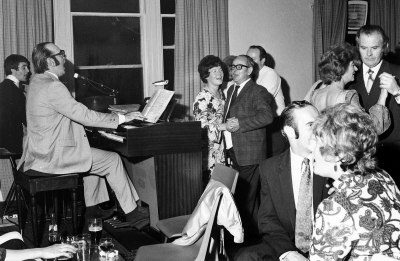Joan Bassett
In this essay:
In East Lothian in the period after the second world war, music in general was considered by most people to be purely a means of relaxation and entertainment. Very few thought of music as a profession from which one might make a living, unless by becoming a teacher, or as a part-time occupation supported by more remunerative work of some kind. In schools, teaching music was almost entirely confined to singing in class and possibly in a choir. It was not included in the examination curriculum. There was practically no instrumental teaching until after Regionalisation in 1975, yet, outwith the schools, there was much musical activity in the county both before and after Regionalisation. Though largely initiated by amateurs, with a supportive professional role in some cases, it was not until the late 1960s that professional input began to play an important part. By the year 2000 there were over 30 performing groups and other musically-related organisations in East Lothian [see addenda]. Some existed well before the period under consideration and some rose from the ashes of previous organisations. Clearly all these societies and clubs provided much variety and catered for many different tastes.

Early Choirs and The Co-Operative Society
Social changes in the period have had some influence on the development of music in East Lothian. In the late forties and fifties, musical activities were still very much town and village orientated, before the ownership of cars made movement further afield much simpler, and the arrival of the ubiquitous television set made staying in of an evening more attractive. Every town and village appears to have had its own choir. The education department of the co-operative movement had a big influence, giving support to choirs financially and running competition festivals. The largest of the latter was held in the Usher Hall in Edinburgh but others were held in schools around the county. This very worthwhile backing to choirs and other activities from the co-operative movement continued into the 1980s. We may presume that the disappearance of this support was a contributory factor in the demise of many choirs. Obviously the growth of the popular music industry, and the subsequent lessening of the numbers of young people willing to join, was a very real reason for these societies having difficulty in continuing. A lady, who was a member of the Fisherrow Fishwives’ Choir, started c. 1935, reported that the choir ‘fizzled out’ in the 1960s, because ‘we all grew old’.
A body called the East Lothian County Music Committee was formed in 1947, the stated purpose of which was to foster music in the area. A public meeting called by the Committee resulted in the founding of the Dunbar and District Musical Society in 1949 (later to become the Dunbar and District Choral Society), and the opening of a non-competitive County Music Festival, held in the Corn Exchange in Haddington in 1951. In the Festival of 1952, choirs from Dunbar, Tranent, Cockenzie (linked with Port Seton), Prestonpans, Haddington, Longniddry, North Berwick, Ormiston, as well as St Mary’s Church Choir (presumably Haddington Parish Church) and the church choir of St Andrew’s, East Linton, all took part.
The Lamp of Lothian
The formation of the Lamp of Lothian Collegiate Trust in 1967, with its pledge ‘to induce the growth of a “whole community”‘ was probably the most influential force in the arts during this period. The Lamp became deeply involved with the restoration of St. Mary’s Parish Church in Haddington, which, aside from its liturgical role, provided the only central venue for concerts of any size. In addition the Lamp became promoters for classical concerts of a highly professional nature. The legendary recital given at the start by Yehudi Menuhin in the ruins of the choir of the church before restoration, was the inspiration which led eventually to the summer season of six concerts each year and which attracted favourable notice throughout the musical world. St. Mary’s became a preferred venue for many musicians; orchestras, chamber musicians, pianists, and choirs were not infrequent users of the facilities. The installation of the new organ in 1990, built by East Lothian organ builder Neil Richerby, was a magnet for organists keen to give recitals. Improved road links between East Lothian and Edinburgh made it easier to attract performers, and city music-lovers increasingly became aware of the good music available in the county.
East Lothian Music Workshop
In 1974, Francesca Loening, a very experienced violinist, who had just moved to East Lothian, applied for a post as violin teacher at one of the Haddington primary schools. She discovered that she was apparently the only instrumental teacher in the whole of the county. To help to rectify this situation, in 1976 she started the East Lothian Music Workshop that met in premises supplied by the Lamp of Lothian at a reasonable rate. Her purpose and that of her associate, Julienne Cartwright, was to give children who wished to learn an instrument the opportunity to do so. 40 children attended the workshop. With no funding other than the proceeds of concerts, holding jumble sales etc., she managed to attract experienced music teachers from Edinburgh and surrounding districts to come to Haddington. The workshop also subsidised some fees for lessons. This excellent initiative must have gone some way to alerting people to the need for this extension to musical education. Certainly after East Lothian became part of the Region in 1975, instrumental teaching began to be introduced in the schools. By the early 1980s, there was thought to be less need for the workshop and it closed in 1984.